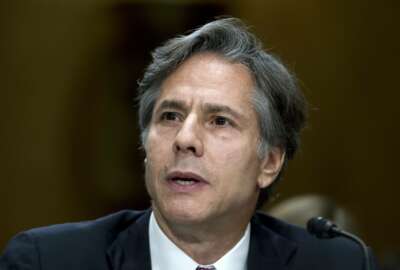
How to diversify and include? Hint: It starts with you
Consider becoming a mentor to someone who doesn't look like you.
When I first came to work in Washington 30 years ago, I soon noticed that the government appeared way more diverse, in terms of women and Black individuals, at upper levels. Several flag-rank military officers I met were Black. I met women — in a few cases, Black women — who were running large programs.
By contrast, in the corporate world, in those days and earlier, women who made it to high ranks were nearly always in public relations or personnel. Rarely finance or engineering. So a good deal of progress has occurred. In my own mind, and at least in the modern era, the government has appeared to be somewhat ahead of the private sector when it comes to the whole question of diversity and inclusion.
President Biden might have taken it a few steps further, but presidents have been appointing minorities and women to cabinet and sub-cabinet appointed positions for decades. This week a bipartisan group of Senators reintroduced a bill to name the Transportation Department headquarters building after former Secretary Bill Coleman, who died in 2017. He was Black and was appointed by President Ford. More than that, Coleman was an accomplished lawyer with a striking list of federal assignments. For example, he questioned Fidel Castro for three hours on a fishing boat after the assassination of President Kennedy, at the behest of the Warren Commission.
Big shows of high level political appointees, though, have two problems. First, they often parade the nominees as beads drawn from a particular concave of an egg crate, rather than as talented or competent individuals in their own right. Second, they don’t translate into regular and fair opportunity for minorities in the day-to-day functioning of the civil service. Groups representing Black or Hispanic employees regularly point to statistics showing that more-or-less proportional representation at the lower ranks somehow doesn’t extend to the higher ranks or to the Senior Executive Service.
Another gesture comes from Secretary of State Antony Blinken, who has formed a “leadership council” within State devoted to diversity and inclusion. It will be made of designated diversity and inclusion people at the bureau level. Specifically, the deputy assistant secretaries. State will also have a diversity and inclusion officer, dubbed DCIO, who will report to Blinken. In a Q&A with reporters, the State Department spokesman said it is Blinken’s intention to prioritize diversity and inclusion at all levels, up to that of ambassador.
One reporter pointed out that the same profession — that is, of desire for greater diversity — has come from the lips of every Secretary of State since at least the Clinton administration. “And it never seems to get any better,” the reporter added. In fact, the reporter went further, pointing out that Blinken had himself spent four years as deputy secretary during the Obama administration. “It’s not as if they weren’t in positions of leadership before, prior to four years ago. Why now? Why all of a sudden now? This has been a problem that’s gone back decades. Why didn’t they do something about it then?”
Good question, and good for that reporter Matt, whoever it was, for a challenging question.
The spokesman answered as people in that position do. He talked about changing the culture, that no one is satisfied with the results, that State has never until now asked deputy assistant secretaries to track this issue.
The culture idea, though, is the key. Culture is an overworked word. In this context, a culture of making sure everyone gets a fair chance has to exist below the very top level of leadership.
My evidence comes partly from a series of more than a dozen interviews on this topic that I’ve aired over the past year or so. Three Black federal executives mentioned that throughout their careers, they had mentors, both Black and White, who recognized their talents and who helped make sure they had assignments of increasing responsibility. You can hear three of them: Dr. Reginald Wells, who reached the level of deputy commissioner at the Social Security Administration; as well as Navy Rear Admiral Alvin Holsey and Force Master Chief Huben Philip, who recently led the Navy’s task force on diversity and inclusion.
Today, as this column is posted and as Black History Month comes to an end, I’m airing an interview with Tyra Dent Smith. She’s the executive director of the African American Federal Executives Association. Before that, she spent 40 years in federal service. Smith started as a GS-4 and retired as the deputy chief human capital officer at the Commerce Department and a member of the SES. Smith notes that she came in with a college degree, and didn’t quite understand how that merited a GS-4.
“Definitely over that time I received support, I received mentoring, sponsorship, opportunities to really develop and grow my skills and my competencies,” Smith told me. “And then to be in positions that allowed me to actually demonstrate and activate those skills and competencies in some very fascinating roles in the federal sector.”
Likely none of that came from whomever was secretary of the department, but rather from sensitive and willing colleagues a notch or two higher on the pecking order. People who took personal responsibility for ensuring the right things happened. There’s nothing stopping any individual from taking the inclusion gestalt as one’s own mission, regardless of what is or isn’t coming from the political head.
Nearly Useless Factoid
By Alazar Moges
Because Alaska and Hawaii officially became states during his tenure, Dwight D. Eisenhower was the first president to reside over all 50 states.
Source: World Atlas
Copyright © 2024 Federal News Network. All rights reserved. This website is not intended for users located within the European Economic Area.
Tom Temin is host of the Federal Drive and has been providing insight on federal technology and management issues for more than 30 years.
Follow @tteminWFED
Related Stories

National Geospatial-Intelligence Agency takes workforce diversity in a new direction




